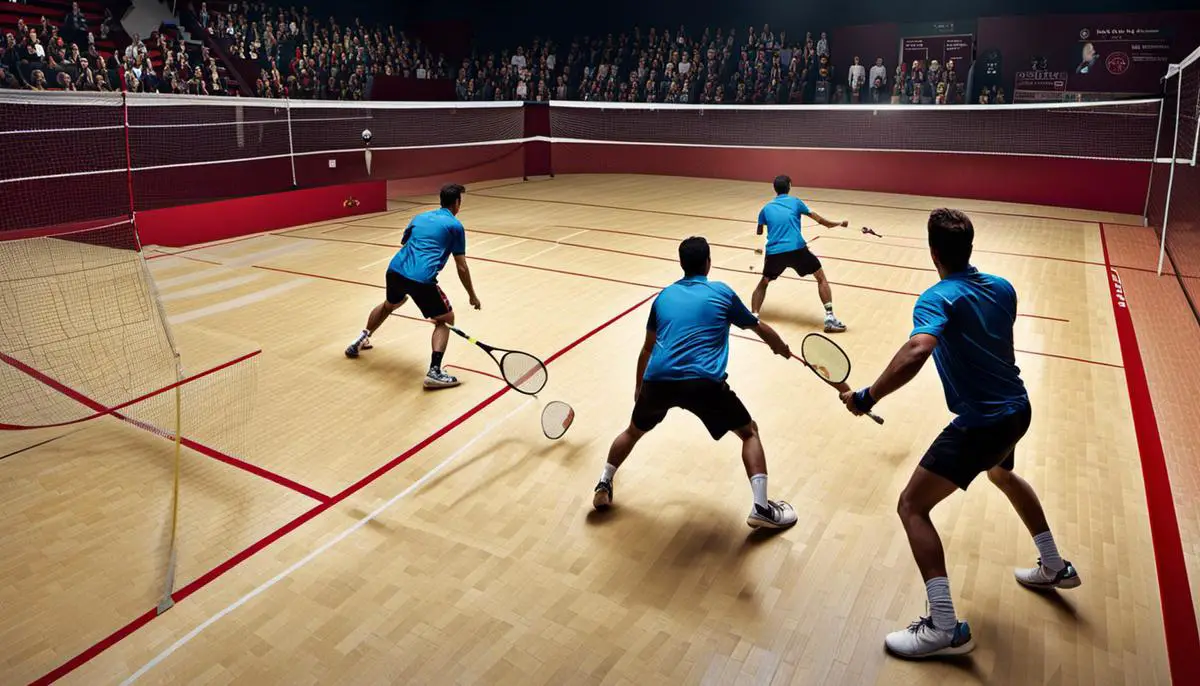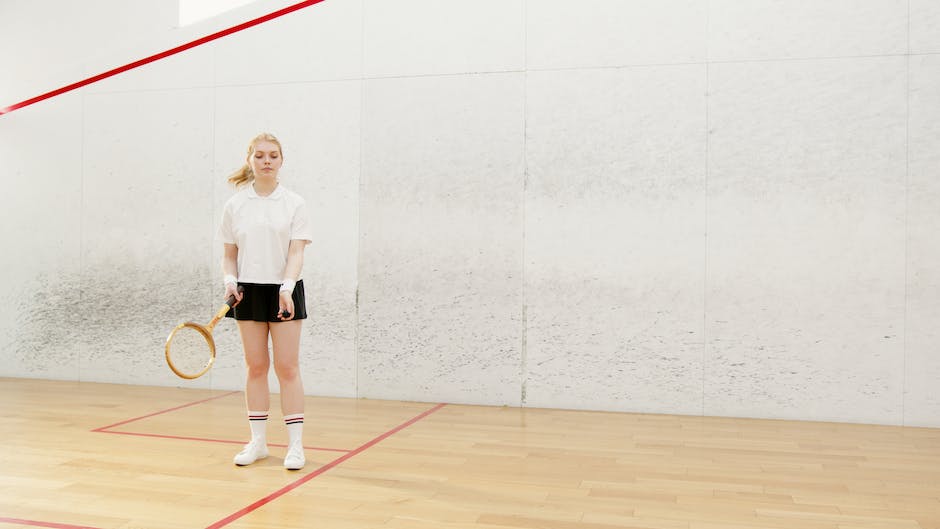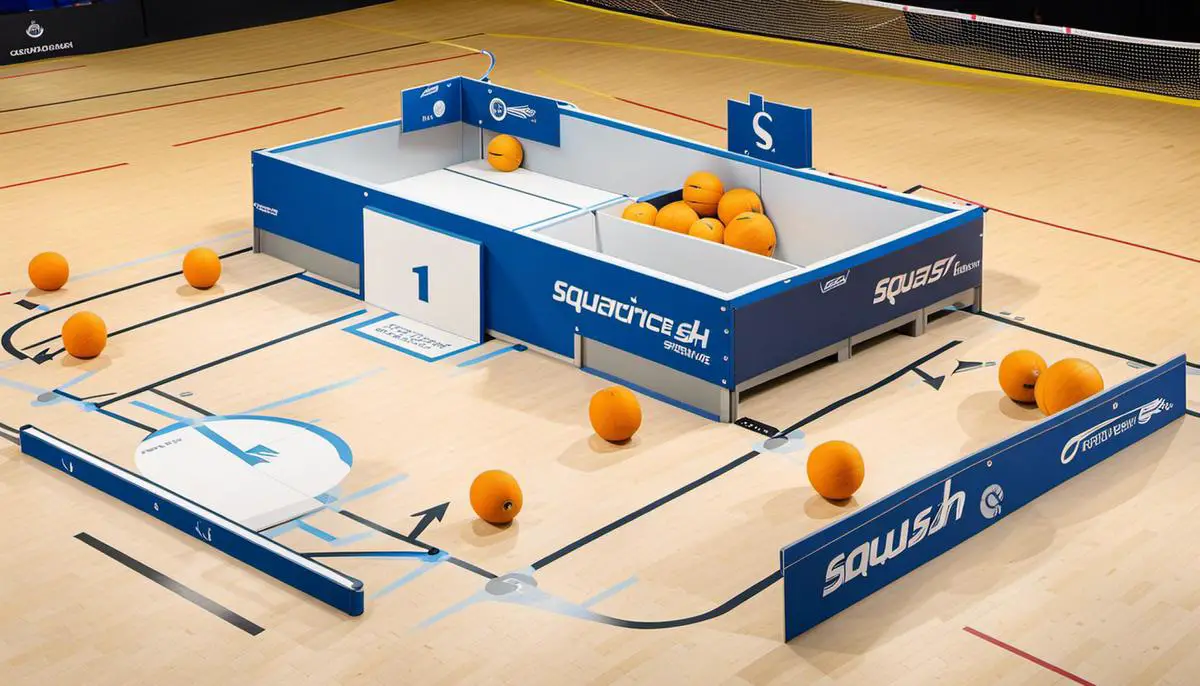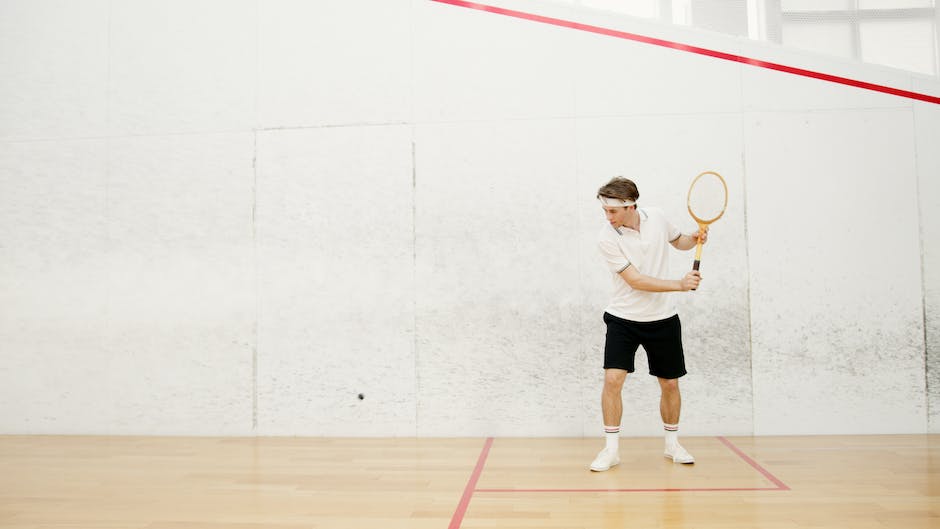Exploring the exciting world of squash, a high-speed racquet sport, demands more than just having a keen understanding of how to swing the racquet and hit the ball; it also involves knowing the essential rules and etiquette of the game. Within this comprehensive look into the realm of squash, we’ll illuminate the basics rules and regulations – including score calculation, the order of play, and understanding boundaries. Additionally, we’ll debunk specific terminologies and elaborate on how to gain or lose points. Further, we dive into the unwritten rules or the common etiquette, pivotal to maintaining professionalism and exemplifying sportsmanship while promoting fair play and resolving disputes amicably. Comprehending these elements lays the groundwork for anyone aiming to fully appreciate or participate in this compelling sport.
Understanding Basic Squash Rules
Understanding Basic Squash Rules
Squash, a racquet sport, is played by two players (singles) or four players (doubles) on a four-wall court. The players alternate hitting a small rubber ball against the front wall using a racquet.
Each squash match consists of three or five games. To win a game, a player needs to score 11 points. If the score ties at 10-10, play continues until a player has a two-point lead. The player who wins the most games wins the match.
Score Calculation and Order of Play
Points can be scored in squash in multiple ways. In the traditional scoring method known as “hand-in-hand-out,” only the server can score. If the server wins the rally, he earns a point, and if the receiver wins, the server is out, and the receiver becomes the server. However, today the more popular scoring system is “point-a-rally” where points can be scored by the server or receiver.
The order of play starts with a player serving from either service box on the court. The opponent needs to return the serve by hitting the ball before it bounces a second time and aim it to hit the front wall. Play continues in a rally with both players trying to prevent the ball from bouncing twice before returning it to the front wall.
Boundaries and Specific Terminology
In squash, when the ball is in play, it should hit the front wall between the board (outline at the bottom) and the outline at the top without touching the floor or the line marking the top of the board. While returning to the opposite player, it must not hit the outline on the side walls or the ceiling.
The ‘tin’ refers to the lower boundary on the front wall, below which the ball cannot hit. If a ball hits the tin, it is considered out and the point is lost. The ‘box’ refers to the service boxes from where the server serves the ball.
Ways to Win and Lose Points
Points in squash can be won if an opponent fails to make a legal return of ball, hits the ball out of court boundaries or strikes the ball more than once before returning.
Conversely, points can be lost if the ball bounces twice before it is returned, if the player hits the ball out of turn, if the player deliberately distracts or obstructs the opponent or if the ball touches the player or their clothing during play.
Etiquette in Squash
Good sportsmanship should prevail in squash. Players are expected to make every effort to clear their shot, providing the opponent a fair view of and access to the ball. If there’s an accidental collision, or if the next striker is hampered, a let (replaying a point) can be requested, but it’s up to the referee’s discretion to award it.
Intentional blocking or dangerous play can lead to strokes against the player or even game loss.
Squash is a fast-paced dynamic sport and understanding these basic rules and etiquette helps in appreciating the game and gearing up for a great match.

Squash Etiquette
Etiquette Rule #1: Respect Opponents and Referees
In squash, it is important to always acknowledge and respect the players and referees’ efforts during a match. This respect should be reflected in your day-to-day interactions, regardless of whether you won or lost. Always remember to shake hands with your opponent(s) and the referee(s) after each game. Congratulate your opponent for a good game and thank the referee for officiating.
Etiquette Rule #2: Safeguard Your Opponent’s Well-being
Safety should always be your first concern when you are playing squash. Never swing your racket recklessly or make any moves that might accidentally harm your opponent. If you are in a position where your swing could potentially injure your opponent, it is best to hold up the swing and let the referee award a let.
Etiquette Rule #3: Always Warm Up the Ball
Before beginning a game, it is a common courtesy to make sure the ball is properly warmed up. This can be done by the server or the receiver. Remember, a properly warmed-up squash ball will help ensure a fair and enjoyable game.
Etiquette Rule #4: Follow the Right of Way
In squash, there is an unwritten rule regarding the right of way. Essentially, the player who has just hit the ball has a right to a clear path to the ‘T’ (the intersection at the middle of the court) and then a freedom of movement to the next shot. If you are not following these rules you may receive a penalty from the referee, or at the very least, some disgruntled comments from your opponent.
Etiquette Rule #5: Handling Disputes
Squash is a high-speed game, and it’s inevitable that there will be some clashes and disputes during the game. When disagreements occur, handle them calmly and professionally. In most situations, the referee will make the final decision. Accept their ruling gracefully, even if you disagree. Remember that good sportsmanship is a key part of squash etiquette.
Etiquette Rule #6: Limit Distraction
Anything that might distract your opponent during a rally is a breach of squash etiquette. Avoid unnecessary movements or noises when your opponent is about to hit the ball. Be aware that talking to your opponent during a rally can be viewed as distracting and inconsiderate.
Etiquette Rule #7: Dress Appropriately
Finally, for the sake of decorum and fairness, dress appropriately for a squash match. This usually means wearing squash shoes (to avoid marking the court) and sports clothing. It is also frowned upon to wear jewelry or watches as these could lead to injuries or damage during the game.

Serving Rules in Squash
Understanding the Service Box in Squash
In Squash, the service box is a crucial point from where the service begins. A standard squash court has 2 service boxes which are located on both sides of the court (left and right). Each player is entitled to choose a preferred service box when starting a new game. After that, the server is obliged to switch service boxes after each point is won.
Service lines in Squash
The service line in squash is located on the front wall, exactly midway up it. When the ball is served, it must land above the middle line, also known as the service line, and below the outlined top section on the front wall. The ball’s first bounce should also hit the opposite half of the back court.
Method of Service in Squash
Serving involves striking the ball so it hits the front wall and landing within the back quarter of the court opposite to the side the server is on. The server has to keep one foot in the service box until they make contact with the ball. If the ball is served correctly and is not volleyed by the receiver, it is allowed to bounce once before being returned.
Understanding Fault Serves in Squash
Fault serves are when the serving fails to meet the rules. This happens when:
- The ball hits the line or out of bounds area on the front wall.
- The ball does not land in the opposite back quarter court after hitting the front wall.
- One or both feet of the server are outside of the service box at the time of the serve.
Once a fault serve occurs, the server loses their opportunity to serve and the opportunity is passed over to the other player.
Etiquette during Squash Serving
Maintaining sportsmanship is essential in squash. The server should ensure the receiver is ready before serving. If a serve is made before the receiver is prepared, it is often considered a let and the server must serve again. Throughout the game, avoiding distractions and honoring the opponent’s space is vital. The server should not intentionally obstruct the receiver’s view of the ball.

Advanced Squash Rules
Understanding Squash Interference and Let Calls
In squash, interference occurs when a player obstructs the movements of their opponent. This can be through blocking the path, making it impossible for the opponent to take a swing, or even obscuring vision of the ball. When interference happens, a “let” is usually called. This refers to a situation where a point is replayed. There are three types of lets: a simple let, a stroke to the opponent, or a no let.
In a simple let, the point is replayed. A stroke is called when a player, attempting to hit the ball, is obstructed by their opponent. In this case, the obstructing player loses the point. A no let is called when a player attempts to call for a let, but the referee or opponent decides that there was no interference, hence the player does not get the replay and also loses the point.
Turns in Squash
Turns in squash are defined by who hit the ball last. After serving, it’s your opponent’s turn to hit the ball before it bounces twice. If your shot is good and hits the front wall above the tin (board) and below the outline, it will be your opponent’s turn. If your opponent hits the ball before you have cleared, and you are struck by the ball before it has hit the wall, then it is your turn to receive a stroke.
Turn-taking continues in this fashion until a player loses the point. If you miss your shot entirely, hit the ball out of the court or into the ground before it reaches the front wall, put the ball into the tin, or don’t leave enough room for your opponent to have a fair shot at the ball (thus causing interference or block), you lose the point.
Understanding Foul Shots in Squash
In squash, foul shots occur when the ball is hit outside the boundaries of the court. These boundaries, marked by out lines, are topmost red lines for the front and side walls. The ball must stay within these lines on all shots or a point is awarded to the other player.
Hitting the ball on or below the board (often referred to as “tin” squash parlance) at the bottom is also a foul. If a player hits the tin, the play stops immediately, and a point is given to the opponent. Additionally, if a player serves and the ball hits the outline or doesn’t reach the service box, it is considered a foul serve, and the opponent is awarded the point.
Advanced Squash Strategies
Understanding advanced squash strategies can take your game to the next level. One strategy is exploiting your opponent’s weak points. If they have a weak backhand, target that area more frequently. Keep in mind, though, that such tactics should be varied. If you continuously hit to the same spot, your opponent will catch on.
Another strategy is to use the corners of the court to your advantage. Make your opponent run more to exhaust them. Successfully implementing this strategy requires understanding your opponent’s position and being able to hit precise shots.
Lastly, mastering the art of deception is an essential offensive strategy. This involves disguising the direction or type of shot until the last possible moment to wrong-foot your opponent. It takes time and practice, but when done correctly, it can be a game-changer.

Having worked our way through the core principles of squash – from understanding the basic to advanced rules, and getting to grips with the integral aspects of serving, we are now better equipped to appreciate the complexities and nuances this sport brings-carrying a holistic understanding of squash. All these elements are brought together to form a dynamic and exhilarating game that keeps players on their toes and spectators on the edge of their seat. As we continue to engage in this sport, we can constantly learn, grow and hone our understanding even further. Remember, the essence of squash lies not only in the power of the shot but also in the spirit of sportsmanship and mutual respect. So let’s bring these lessons onto the squash court and play the game the way it’s meant to be – fair, exciting, and respectful.